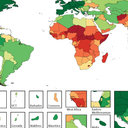First Report of Nigrospora Leaf Blight on Tea Caused by Nigrospora sphaerica in India.
Palavras-chave
Resumo
Tea [Camellia sinensis (L.) O. Kuntze] is an economically important non-alcoholic caffeine-containing beverage crop widely cultivated for leaves in India, especially in the Darjeeling district of West Bengal. In May 2012, distinct blight symptoms were observed on leaves of popular tea cultivars AV-2, Tukdah 78, Rungli Rungliot 17/144, and Bannockburn 157 in commercial tea estates of the Darjeeling district. This disease reduces yield and quality of the leaves. The initial symptoms were frequently observed on the young leaf margins and apices. Foliar symptoms are characterized by grayish to brown, semicircular or irregular shaped lesions, often surrounded by pale yellow zones up to 9 mm in diameter. The lesions later expand and the affected leaves turn grayish to dark brown and eventually the dried tissue falls, leading to complete defoliation of the plant. The disease causes damage to leaves of all ages and is severe in young leaves. A portion of the symptomatic leaf tissues were surface sterilized in 70% ethanol for 30 s, then in 2% NaClO for 3 min, rinsed three times in sterile distilled water, and plated onto potato dextrose agar (PDA). The fungal colonies were initially white and then became grayish to brown with sporulation. Conidia were spherical to sub spherical, single-celled, black, 19 to 21 μm in diameter, and were borne on a hyaline vesicle at the tip of each conidiophore. Morphological characteristics of the isolates were concurring to those of Nigrospora sphaerica (1). Moreover, the internal transcribed spacer (ITS) region of the ribosomal RNA was amplified by using primers ITS1 and ITS4 and sequenced (GenBank Accession No. KJ767520). The sequence was compared to the GenBank database through nucleotide BLAST search and the isolate showed 100% similarity to N. sphaerica (KC519729.1). On the basis of morphological characteristics and nucleotide homology, the isolate was identified as N. sphaerica. Koch's postulates were fulfilled in the laboratory on tea leaves inoculated with N. sphaerica conidial suspension (106 conidia ml-1) collected from a 7-day-old culture on PDA. Six inoculated 8-month-old seedlings of tea cultivars AV-2 and S.3/3 were incubated in a controlled environment chamber at 25°C and 80 to 85% humidity with a 12-h photoperiod. In addition, three plants of each cultivar were sprayed with sterile distilled water to serve as controls. Twelve to 14 days after inoculation, inoculated leaves developed blight symptoms similar to those observed on naturally infected tea leaves in the field. No symptoms were observed on the control leaves. The pathogen was re-isolated from lesions and its identity was confirmed by morphological characteristics. It was reported that N. sphaerica is frequently encountered as a secondary invader or as a saprophyte on many plant species and also as a causative organism of foliar disease on several hosts worldwide (2,3). To our knowledge, this is first report of N. sphaerica as a foliar pathogen of Camellia sinensis in Darjeeling, West Bengal, India, or worldwide. References: (1) M. B. Ellis. Dematiaceous Hyphomycetes. CMI, Kew, Surrey, UK, 1971. (2) D. F. Farr and A. Y. Rossman. Fungal Databases, Syst. Mycol. Microbiol. Lab., ARS, USDA. Retrieved from http://nt.ars-grin.gov/fungaldatabases/ July 01, 2013. (3) E. R. Wright et al. Plant Dis. 92:171, 2008.



